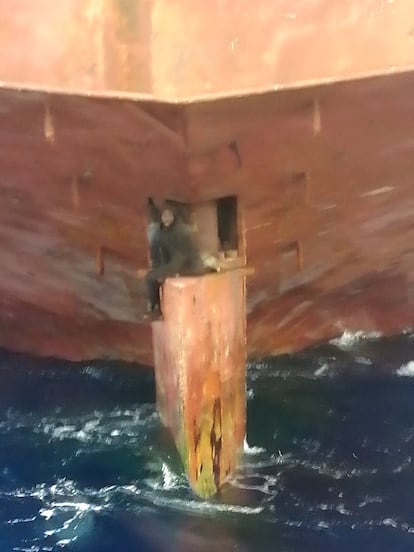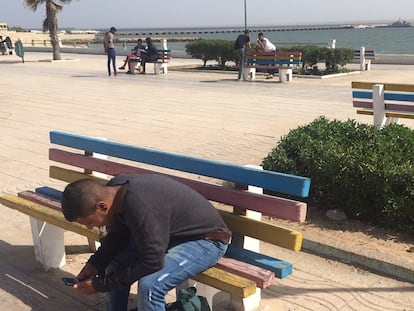A teen’s journey to Spain’s Canary Islands: 15 days on top of a tanker’s rudder
A growing number of migrants are finding increasingly dangerous ways to reach the archipelago, with around 20 stowaways needing to be rescued in just four months


It was the early hours of the morning when Prince, a 14-year-old teen from Nigeria who did not want to use his real name, heard three men in Lagos planning how they were going to board a tanker to reach Spain. He watched as they went down to the port and used a canoe to reach the ship. The men then climbed up a small ladder that reached up to a small compartment in the stern that sits above the rudder. He didn’t think twice: he did the same, jumping in the water and climbing up to the ladder to the rudder.
That’s how Prince found himself aboard Ocean Princess I, a monster spanning 183 meters in length that navigates seas carrying up to 50,000 tons of fuel. He thought the journey would last a few hours, maybe a day. But it took him 15 days, with a stopover in the port of Lomé, the capital of Togo in West Africa. He reached Las Palmas de Gran Canaria in Spain’s Canary Islands on November 23.
In the last four months, around 20 people have been rescued trying to reach the Canary Islands as stowaways on cargo ships. It is impossible to know how many have died on the way.

The journey inside the tiny two-square-meter space above the rudder was terrible. The other stowaways spent most of the time fighting: they had space to sit, but could only lie down and sleep in turns. A tidal wave or a moment of carelessness could lead to their certain deaths in the ocean. “I was very cold, I was very scared, I thought I was going to die,” recalls Prince, in a video call from a center for minors where he is in quarantine. “We didn’t have food and I used the ladder to scoop up water from my hands to drink.”
Ten days into the journey, exhausted and with no sight of land, the situation was desperate. Prince says that the adults were seriously considering throwing themselves into the sea and swimming, even though there was nowhere to go. “We had a hammer and we were hitting the hull of the ship so the crew would get us out of there. They definitely heard us, but no one responded,” says Prince.
“A ship like that has thousands of noises, if you scream no one hears you, and hitting the plate of the hull is the only way to warn the crew. In one of the rescues, it was the captain himself who warned the port after hearing the banging,” explains Manuel Rodríguez, the chief of police at the port of Las Palmas de Gran Canaria.
Sleeping in turns
Las Palmas de Gran Canaria, where large cargo ships stop off on their journey from the African coast to the north of Europe, has always received stowaways. But this way of reaching the Canary Islands, normally anecdotal, has become increasingly popular in 2020. The numbers of stowaways are not high – especially when compared to the 20,000 migrants who reached the archipelago on small boats this year – but their frequency has surprised authorities, who are worried about the dangers involved. In only four months, maritime rescue services have had to intervene five times to remove 20 people from the space over a cargo ship’s rudder. Last year, that number was none.
“They usually climb up when the ships are empty because the hull is less submerged. Normally, the ocean tankers travel without cargo to Europe and come back down loaded with refined fuel. It is a dangerous journey that often ends badly,” says Roberto Bastarreche, the head of the rescue coordination center in Las Palmas de Gran Canaria.
Most of those rescued are young Nigerians who hide in fuel tankers flying flags from Liberia, Greece or even the Marshall Islands. Prince is the first minor to be rescued. Stowaways must sit during the journey, and some have tied rope together in a kind of hammock that can be hung up so they can rest. Without a hammock, they have to agree to sleep in turns and hold one another to stop from falling. “It’s very dangerous, if you fall asleep or there is a tidal wave, you fall or you hit the propeller,” explains Rodríguez. According to his records, as well as the migrants who were pulled out of the small space over the rudder, another 13 stowaways have reached the Canary Islands inside ship containers, storage rooms and other areas of the ship.
Desperation
The reason why migrants are choosing to undertake such a dangerous journey is the same one that pushes them to attempt risky sea crossings in overcrowded boats to the Canary Islands: desperation and a crackdown on other routes. “Captains and shipowners have strengthened security to stop stowaways from boarding their ships. When they [migrants] reach certain ports like Lagos or Conakry [the capital of Guinea], these guys are forced to look for other systems. They usually climb on board the moment the ship sets sail, thanks to a small boat that sits behind and helps them climb up,” says Rodríguez. Shipping companies, according to the officer, are already trying to seal off the hollow space on top of a ship’s rudder to stop stowaways from hiding there.
Stowaways are subject to different regulations than undocumented migrants who arrive by boat. After being rescued, the stowaways are the responsibility of the ship’s captain, who must tell each port on his route that he is traveling with stowaways on board. In this case, it is the shipping company that covers the cost of the migrant’s food, accommodation and interpreter needs, and it must also assume the responsibility of returning the passengers to their country of origin. As with the case of Prince, the police can order the ship to hand over the stowaways so they can stay on land, if they believe that they could be subject to inhuman or degrading treatment on board, or if the stowaway is vulnerable, for instance an asylum seeker, a minor or suffering from a serious illness.
Prince, who has been highly praised by the care workers at the minors’ center, seems more mature than other boys of his age and he is earnest during the interview with EL PAÍS. He says that he finished high school in Lagos but his family was not able to pay for further studies. “I wanted a better life,” he says. He left without telling his mother or his older sister, whom he looks up to, or his two younger brothers. “If I had told them, they would never have let me come,” he explains. The first day that he slept and ate properly after being rescued, he felt “victorious.” He is already planning what to do next: he wants to be a lawyer.
English version by Melissa Kitson.
Tu suscripción se está usando en otro dispositivo
¿Quieres añadir otro usuario a tu suscripción?
Si continúas leyendo en este dispositivo, no se podrá leer en el otro.
FlechaTu suscripción se está usando en otro dispositivo y solo puedes acceder a EL PAÍS desde un dispositivo a la vez.
Si quieres compartir tu cuenta, cambia tu suscripción a la modalidad Premium, así podrás añadir otro usuario. Cada uno accederá con su propia cuenta de email, lo que os permitirá personalizar vuestra experiencia en EL PAÍS.
¿Tienes una suscripción de empresa? Accede aquí para contratar más cuentas.
En el caso de no saber quién está usando tu cuenta, te recomendamos cambiar tu contraseña aquí.
Si decides continuar compartiendo tu cuenta, este mensaje se mostrará en tu dispositivo y en el de la otra persona que está usando tu cuenta de forma indefinida, afectando a tu experiencia de lectura. Puedes consultar aquí los términos y condiciones de la suscripción digital.
More information
Últimas noticias
Most viewed
- Sinaloa Cartel war is taking its toll on Los Chapitos
- Oona Chaplin: ‘I told James Cameron that I was living in a treehouse and starting a permaculture project with a friend’
- Reinhard Genzel, Nobel laureate in physics: ‘One-minute videos will never give you the truth’
- Why the price of coffee has skyrocketed: from Brazilian plantations to specialty coffee houses
- Silver prices are going crazy: This is what’s fueling the rally










































